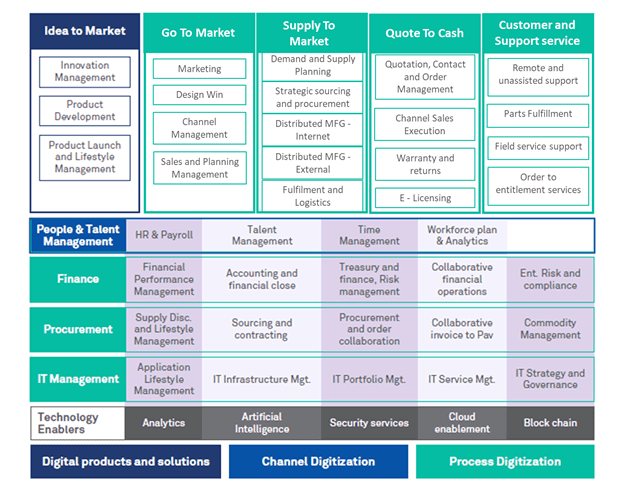
The digital era brought tech-savvy consumers that expect newer versions at accelerated rates without compromising on the end-user experience. This puts pressure on the hi-tech industry to continuously offer new or upgraded products with tremendously short product lifespans. They also face stiff competition in this digital era from new entrants, which impact revenue and profit growth.
As the digital market continues to grow, there is a need to evaluate investments at every juncture. How and where to implement digital solutions are crucial questions businesses must answer to receive the most return on investments. Increasingly, the industry is focusing on service-centric solutions instead of traditional product-based offers.
With that in mind, the hi-tech industry should focus on these dimensions to drive revenues and profitability:
As companies go digital, they must embrace the principals of design thinking to re-imagine the user experience and industrial design. The user interface (UI)/user experience (UX) is one area in product development that is constantly changing, making an agile approach critical despite the complications it can create around supply chain relationships. Cloud-based services enable companies to provide value across the product development life cycle, improve customer service and allow for the implementation of smart factories. Insights-as-a-Service, which is where a company leverages product analytics, allows companies to evaluate their products and identify the most efficient system or product, which in turn, allows the company to identify offerings that support company growth.
The hi-tech industry often relies on channel partners to market and sell their technology and solutions to end customers. In order to deliver the right experience for channel partners, companies must invest in portals and create new service models. The change from a product-centric to service-centric model involves a complete overhaul of the service design and core organizational sequence. The implementation of a service platform involves looking at where marketing, sales, billing and associated services can help support subscription models versus fixed licensing models.
In the journey for operational efficiency, companies in the global hi-tech industry are digitizing their core front office and back office procedures. Some companies are using robotic process automation (RPA), artificial intelligence (AI) and advanced analytics to augment their existing processes and drive efficiency.
At the core, companies must reimagine the journey from both an end customer and sales agent perspective, and then identify opportunities to capture insights, digitize and streamline the business processes. Today, customer care is seeing an influx in automated processes wherein customer issues get proactively resolved even before the end customer is aware of the problem. AI is being used here to assist customer support services through chatbots and to create cross-sell or upsell opportunities by using an AI-based recommendation engine.
Technology advancements continue to disrupt all industries at a rapid pace. How businesses adapt to these changes will determine the long-term success of a company. The hi-tech companies that build their products and solutions, digitize their channels and streamline their business processes based on the needs of their end customers and partners will be the ones that can successfully differentiate themselves, which in turn, will help them outlast the competition.

About the Author
David Ranjit William, Digital Head, Technology BU, Wipro Ltd.
David has over 20 years of IT experience working in the Communications & Hi-Tech industry. He is responsible for driving the Digital strategy for the Technology BU at Wipro.
FEATURE | By Rob Enderle,
December 04, 2020
ARTIFICIAL INTELLIGENCE | By Guest Author,
November 18, 2020
FEATURE | By Guest Author,
November 10, 2020
FEATURE | By Samuel Greengard,
November 05, 2020
ARTIFICIAL INTELLIGENCE | By Guest Author,
November 02, 2020
ARTIFICIAL INTELLIGENCE | By Rob Enderle,
October 29, 2020
ARTIFICIAL INTELLIGENCE | By Rob Enderle,
October 23, 2020
FEATURE | By Rob Enderle,
October 16, 2020
FEATURE | By Cynthia Harvey,
October 07, 2020
ARTIFICIAL INTELLIGENCE | By Guest Author,
October 05, 2020
FEATURE | By Guest Author,
September 25, 2020
FEATURE | By Rob Enderle,
September 25, 2020
FEATURE | By Cynthia Harvey,
September 22, 2020
ARTIFICIAL INTELLIGENCE | By Rob Enderle,
September 18, 2020
ARTIFICIAL INTELLIGENCE | By James Maguire,
September 14, 2020
ARTIFICIAL INTELLIGENCE | By James Maguire,
September 13, 2020
FEATURE | By Rob Enderle,
September 11, 2020
FEATURE | By James Maguire,
September 09, 2020
FEATURE | By Rob Enderle,
September 05, 2020
ARTIFICIAL INTELLIGENCE | By Rob Enderle,
August 14, 2020

Datamation is the leading industry resource for B2B data professionals and technology buyers. Datamation's focus is on providing insight into the latest trends and innovation in AI, data security, big data, and more, along with in-depth product recommendations and comparisons. More than 1.7M users gain insight and guidance from Datamation every year.
Advertise with TechnologyAdvice on Datamation and our other data and technology-focused platforms.
Advertise with Us
Property of TechnologyAdvice.
© 2025 TechnologyAdvice. All Rights Reserved
Advertiser Disclosure: Some of the products that appear on this
site are from companies from which TechnologyAdvice receives
compensation. This compensation may impact how and where products
appear on this site including, for example, the order in which
they appear. TechnologyAdvice does not include all companies
or all types of products available in the marketplace.